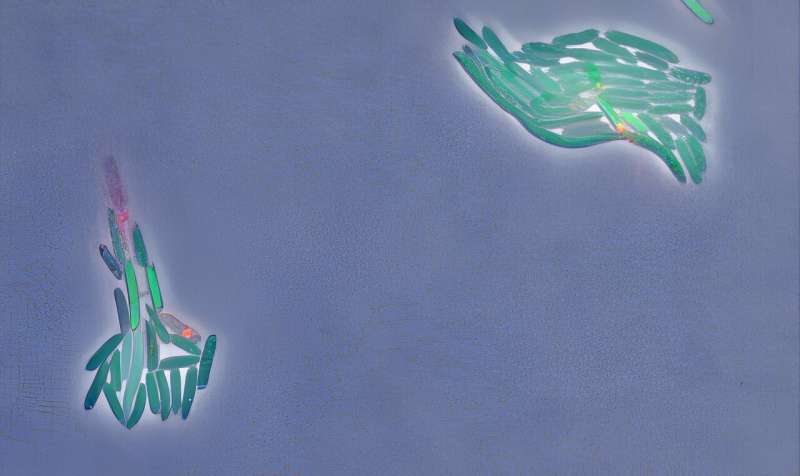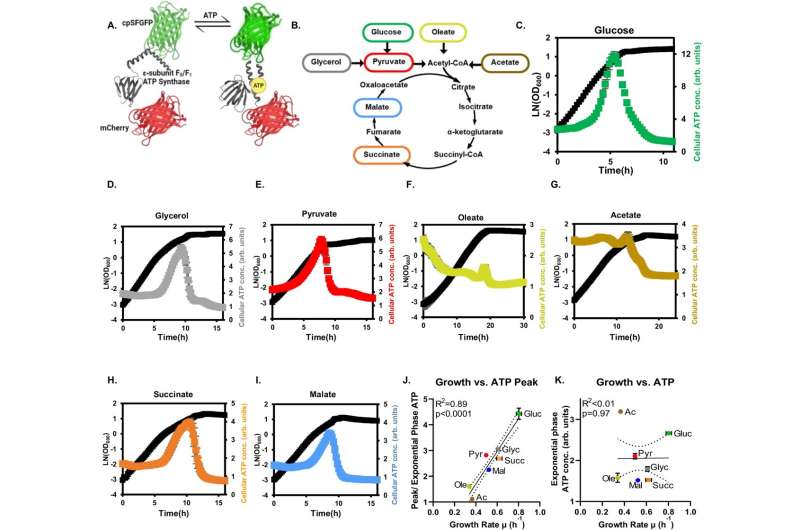This article has been reviewed according to Science X's editorial process and policies. Editors have highlighted the following attributes while ensuring the content's credibility:
fact-checked
peer-reviewed publication
trusted source
proofread
ATP's role in biomanufacturing: Fluctuating cellular energy drives microbial bioproduction

In the work of biomanufacturing, tanks of microbes are fine-tuned to produce compounds that can be used as carbon-neutral fuels, chemicals, materials and medicines, but researchers are still learning the basics of how to turbo-charge microbes for production. To that end, engineers at Washington University in St. Louis have explored the roles of ATP in microbial metabolism.
Adenosine-5'-triphosphate (ATP) is the primary energy currency that fuels many cellular processes, but its levels fluctuate wildly in microbes used in manufacturing, so it is critical to map the connections between ATP levels and microbial growth and nutrient quality and how that affects yields of the microbial products.
Fuzhong Zhang, a professor of energy, environmental and chemical engineering at the McKelvey School of Engineering and co-director of the Synthetic Biology Manufacturing of Advanced Materials Research Center (SMARC), led the research to understand ATP dynamics in various fermentation conditions and developed a cost-effective approach to enhance bioproduction through supplementation of ATP-promoting carbon sources. The results were published June 21 in Nature Communications.
"This study has broad implications for understanding microbial energy homeostasis, optimizing bioproduction processes, and identifying sources of metabolic burden," said Xinyue Mu, a Ph.D. student in Zhang's lab and first author of the paper.
This work used a genetically encoded ATP biosensor to explore the rapid changes of ATP concentration in various microbial cells and fermentation conditions. They found that feeding microbes with different carbon sources results in very different ATP dynamics.
Among the tested carbons commonly used for fermentation, acetate induced the highest ATP levels in E. coli while Pseudomonas putida, a microbial strain widely used by the fermentation industry, prefers a fatty acid called oleate.

"Normally, you wouldn't think acetate is a good carbon source for E. coli," said Mu, noting that acetate is considered a byproduct of glucose metabolism, something E. coli excretes when eating glucose. "Actually, by feeding it acetate, we see a higher ATP level associated with an enhanced yield of target products."
It's also good news for using acetate as feedstock because researchers at McKelvey Engineering also are working on methods that can convert carbon dioxide to acetate.
P. putida produces a bioplastic called polyhydroxyalkanoate (PHA). In this case, feeding P. putida its preferred feedstock—fatty acids—substantially enhanced PHA content, yields and productivity.
In addition to finding the beneficial carbon sources for fermentation, the ATP biosensor also shined light into the cells' complicated metabolic processes.
Limonene can be microbially produced and used as a renewable solvent or jet fuel, but its bioproduction drastically sucks up ATP and reduces cell growth as well as limonene yield.
Using the ATP biosensor, they're starting to understand how the expression of limonene biosynthesis enzymes affects ATP balance and how to tune the enzyme expression accordingly to maintain high yields.
"This work not only elucidates the relationship between ATP dynamics and bioproduction, but also offers a simple and effective strategy to enhance bioproduction by choosing an ATP-beneficial feedstock. It is useful to various biomanufacturing systems," Zhang said.
More information: Xinyue Mu et al, ATP biosensor reveals microbial energetic dynamics and facilitates bioproduction, Nature Communications (2024). DOI: 10.1038/s41467-024-49579-1
Journal information: Nature Communications
Provided by Washington University in St. Louis





















